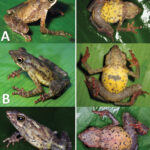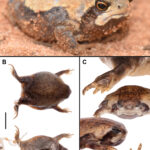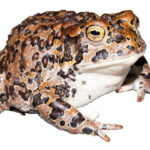Atelopus monohernandezii: The Rare Jewel of Colombian Forests#
In the mist-laden montane forests of Colombia hides a vivid treasure—the critically endangered Atelopus monohernandezii, known by many as the Hernandez’s Stubfoot Toad. Draped in striking hues of vibrant greens and blacks, this harlequin toad is both mesmerizing and tragically mysterious. Named to honor Colombian ecologist Mono Hernández, its presence symbolizes the delicate ecological tapestry of the valleys and streams tucked between Andean ridges. Today, facing alarming declines, this charismatic amphibian has become a poignant symbol in the quest to preserve biodiversity and restore balance to some of Latin America’s richest ecosystems.
Taxonomy and Classification#
Atelopus monohernandezii belongs to Bufonidae, the extensive frog family commonly known as true toads. Within this family is the uniquely vibrant, yet imperiled genus Atelopus, better known collectively as harlequin toads. Famous for their kaleidoscopic patterns and toxic secretions, these toads have fascinated naturalists and biologists alike for decades. Yet among more than ninety recognized species of Atelopus, many today teeter precariously on the brink of extinction due to habitat destruction and disease.
The classification breakdown of this species is as follows:
- Kingdom: Animalia
- Phylum: Chordata
- Class: Amphibia
- Order: Anura
- Family: Bufonidae
- Genus: Atelopus
- Species: Atelopus monohernandezii
This distinct classification positions A. monohernandezii as an important relative to iconic and similarly threatened species like the Panamanian golden frog.
Natural Habitat#
A World Above the Clouds: Colombian Montane Forests#
To catch a glimpse of Atelopus monohernandezii, one must ascend into the cloud-soaked forests of Colombia’s northern Andes, notably in the Serranía de los Yariguíes and Sierra Nevada de Santa Marta regions. Here, under a constant shroud of mist, these high-altitude forests teem with life, water droplets glistening upon orchids, epiphytes, and ferns, enveloping landscapes in verdant beauty.
This stubfoot toad’s specific habitat preference is intricately tied to moist microclimates found usually between elevations of 1,400 and 2,800 meters above sea level. Quiet streams, trickling through rocky substrates and lush vegetation, provide vital breeding grounds, while fallen leaves and moist rocks along stream banks offer optimal shelters from predators and harsh weather.
The amphibian’s existence here is no mere happenstance; it’s a meticulously tuned adaptation. Their delicate skin, sensitive to temperature fluctuations, demands high humidity, which the cloud forests provide in abundance. Sadly, this niche specialization also makes them highly vulnerable to habitat disturbances and climatic shifts.
Physical Characteristics#
A Kaleidoscope of Nature’s Own Making#
Upon first sight, the observer is immediately captivated by the striking appearance of this diminutive creature. Measuring merely 3 to 5 centimeters from snout to vent, A. monohernandezii is undeniably small yet visually powerful. Its glossy skin exhibits bold color patterns—brilliant greens juxtaposed sharply against deep ebony patterns—nature’s bold proclamation of toxicity to would-be predators.
Its slim, elongated limbs, typical of the genus, end in reduced webbing and peculiar “stubbed” toes—hence the distinctive name “stubfoot.” This morphological trait facilitates climbing along wet rocks, stabilizing their agile but careful movements within precarious streamside habitats.
The vivid coloration is far more than ornamental; it serves as aposematic coloration—a stern warning to predators of potent toxins secreted through tiny glands hidden beneath their vibrant exterior. This remarkable adaptation is one that underscores nature’s artful strategy for survival.
Behavior and Life Cycle#
The Quiet Lives of Stream Guardians#
Atelopus monohernandezii lives a quiet existence, diligently hunting diminutive insects, ants, and mites. These meals are carefully picked off low foliage or leaf litter on the forest floor. The rhythm of their life revolves around moisture and temperature. Most active during the cooler hours of early morning and twilight, their movements proceed at a deliberate, cautious pace, always aware of lurking predators such as birds, snakes, and larger mammals.
A Fragile Process: From Egg to Adult#
The breeding season corresponds with rainy periods, as precipitation swells forest streams into ideal nurseries for their offspring. Males arrive at breeding sites first, staking territorial claims with soft, melodic calls reminiscent of wind chimes. Females respond to these gentle serenades, engaging in amplexus—a mating embrace—until they lay gelatinous strings of eggs clinging securely to submerged rocks.
Within weeks, larvae emerge as tiny tadpoles, well-equipped with specialized mouthparts that help them graze upon algae. Their subsequent metamorphosis into miniature adults is a phase marked by remarkable vulnerability; naturally, mortality rates remain high. Nonetheless, those who survive this tumultuous beginning exhibit resilience, etched into the hidden corners of this magical forest.
Ecological Role#
As both predator and prey, Atelopus monohernandezii plays a multifaceted role in maintaining ecosystem stability. These amphibians limit pest populations, checking insect outbreaks that could otherwise disrupt the delicate vegetation balance. In turn, harlequin toads provide important sustenance for larger predators, offering nutrient transfer throughout the forest’s complex food web.
Furthermore, their sensitivity acts as an early-warning system—a biological indicator species demonstrating environmental health. The very presence or absence of these frogs sends a clear message regarding the ecological integrity of their habitats.
Threats and Conservation Status#
The Unseen Peril of Extinction#
According to the IUCN Red List, Atelopus monohernandezii currently possesses the sobering status of Critically Endangered. Population declines result primarily from habitat loss due to agriculture, logging, and urbanization that fragment formerly contiguous landscapes. Yet, an even more menacing threat remains invisible to the naked eye—chytridiomycosis, an insidious fungal disease rapidly decimating global amphibian populations.
Climate change compounds these threats further, altering moisture availability and temperatures crucial for their survival. Conservation measures now involve habitat restoration, captive-breeding programs, disease mitigation, and increased local community participation to safeguard these frogs’ future.
Cultural and Scientific Significance#
In Colombia, frogs like Atelopus monohernandezii symbolize more than mere biodiversity—they represent cultural identity, ecological wisdom, and ancient legends. Indigenous cultures have traditionally respected such species as guardians of water, fertility, and balance. Scientifically, their unique alkaloid toxins open doors to medical discoveries with potential therapeutic applications, further reinforcing why their conservation matters immensely.
Conclusion#
Atelopus monohernandezii deserves our admiration, respect, and urgent conservation actions. Its survival illustrates our collective commitment to protecting ecosystems that sustain countless lives, including ours. As lovers of nature, the protection of these stunning amphibians—guardians of a healthier ecosystem—becomes our shared responsibility.
Act now: support organizations working to conserve these remarkable frogs, educate those around you, and join conservation initiatives. Ensuring their survival not only saves a single species but also enriches the rich tapestry of life for generations yet to come.







